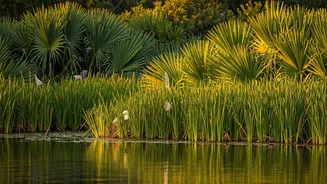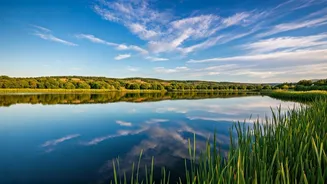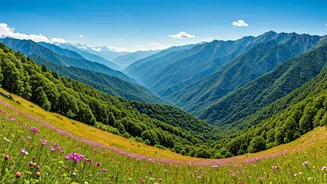Introduction: Natural Wonders
India's national parks are vibrant havens, each a testament to the country's diverse natural heritage. They range from the high-altitude forests of the Himalayas
to the tropical rainforests and coastal ecosystems of the south. These protected areas are essential for preserving biodiversity, safeguarding endangered species, and offering unique opportunities for wildlife viewing, trekking, and immersing yourself in nature. This article focuses on ten remarkable national parks, highlighting their unique features and the experiences they offer.
Jim Corbett National Park
Established in 1936, Jim Corbett National Park stands as India's oldest national park and a pioneer in tiger conservation. Located in the Nainital district of Uttarakhand, this park is known for its high tiger population and offers fantastic opportunities for wildlife safaris. Its diverse topography includes hills, grasslands, and riverine belts, creating a habitat for various animals, including elephants, leopards, deer, and diverse bird species. Visitors can explore the park through jeep safaris, elephant rides, and by staying in forest lodges to fully experience the natural beauty and wildlife of Jim Corbett.
Kaziranga National Park
Kaziranga National Park, located in Assam, is a UNESCO World Heritage Site and a global icon for one-horned rhinoceros conservation. The park's flat grasslands and wetlands provide a perfect habitat for these magnificent creatures. Beyond rhinos, Kaziranga also supports healthy populations of tigers, elephants, water buffalo, and a variety of bird species. The park's safari experiences often provide unique sightings of these animals in their natural habitat, making it a truly unforgettable experience. The best time to visit Kaziranga is during the dry season, from November to April, when the weather is ideal for wildlife viewing.
Ranthambore National Park
Ranthambore National Park, in Rajasthan, offers a glimpse into the wild heart of India. Once the hunting grounds of the Jaipur royal family, this park is now a renowned tiger reserve. The park's arid landscape, dotted with historical forts and lakes, provides a unique backdrop for wildlife safaris. Besides tigers, Ranthambore is home to leopards, sloth bears, various species of deer, and birds. Jeep safaris are the main way to experience the park's wildlife, and the sightings of tigers are frequent, making it a popular destination for wildlife enthusiasts and photographers.
Sundarbans National Park
The Sundarbans National Park, located in West Bengal, is the world's largest mangrove forest and a UNESCO World Heritage Site. This unique ecosystem is home to the Bengal tiger, adapted to the mangrove environment. The park’s waterways and dense forests also provide habitats for various species of birds, reptiles, and invertebrates. Boat safaris are the primary way to explore the Sundarbans, offering a unique perspective on this remarkable ecosystem and the chance to spot tigers and other wildlife within this distinctive habitat. The best time to visit is during the winter months, from November to February.
Periyar National Park
Periyar National Park in Kerala is a biodiversity hotspot centered around the Periyar Lake. The park is renowned for its elephants, tigers, and a diverse range of other animals, including the Nilgiri tahr and various bird species. Boat safaris on Periyar Lake provide excellent opportunities to observe wildlife, while trekking trails offer closer encounters with nature. The landscape is characterized by evergreen forests, grasslands, and the serene lake, creating a picturesque setting for wildlife viewing and exploration. The climate remains pleasant for the most part of the year, making it an all-season destination.
Kanha National Park
Kanha National Park in Madhya Pradesh is famous for its tiger population and is also the inspiration behind Rudyard Kipling's 'The Jungle Book'. The park's diverse terrain, from sal forests to grassy meadows, supports a wide range of wildlife. This includes the tiger, leopard, gaur (Indian bison), and various species of deer. Safari options, including jeep safaris, give visitors an opportunity to discover the park's lush environment and spot the wildlife. Kanha's beauty and biodiversity make it a prime destination for naturalists and wildlife enthusiasts.
Gir National Park
Gir National Park in Gujarat is the only natural habitat of the Asiatic lion. The park's deciduous forest environment provides a conducive environment for lions to thrive. Gir's conservation efforts have resulted in a significant increase in the lion population. Besides lions, the park is home to leopards, various deer species, and numerous bird species. The park provides jeep safaris with guides to spot lions and other wildlife. Visiting Gir National Park is a chance to see a successful wildlife conservation story firsthand.
Bandhavgarh National Park
Bandhavgarh National Park in Madhya Pradesh is known for its high density of tigers and ancient fort ruins. The park has a unique landscape, a mix of grasslands, hills, and forested areas. This diverse environment supports a variety of wildlife, including tigers, leopards, and various species of deer. Jeep safaris are the most popular way to explore the park, offering frequent opportunities to spot tigers. Bandhavgarh's rich biodiversity and historical sites combine to offer a memorable experience for visitors.
Nanda Devi National Park
Nanda Devi National Park, located in Uttarakhand, is a UNESCO World Heritage Site in the high-altitude Himalayas. The park includes the Nanda Devi peak, India's second-highest mountain. This park is known for its stunning alpine meadows, glaciers, and a wide array of high-altitude flora and fauna. The park's rugged terrain provides a habitat for snow leopards, Himalayan brown bears, and various other species. The park is popular for trekking and offers amazing views and experiences, while permitting remains a critical necessity to enter the park.
Concluding Thoughts: Planning
Exploring India's national parks is a remarkable adventure, offering a chance to witness the beauty of nature and the diversity of wildlife. When planning a visit, consider the best time to visit, make necessary bookings, and familiarize yourself with park regulations. These parks not only provide opportunities for wildlife viewing and adventure but also promote conservation. The experience is not just a vacation but a deep connection with nature and a chance to support the conservation efforts in India. Prepare to be amazed by the natural wonders.










